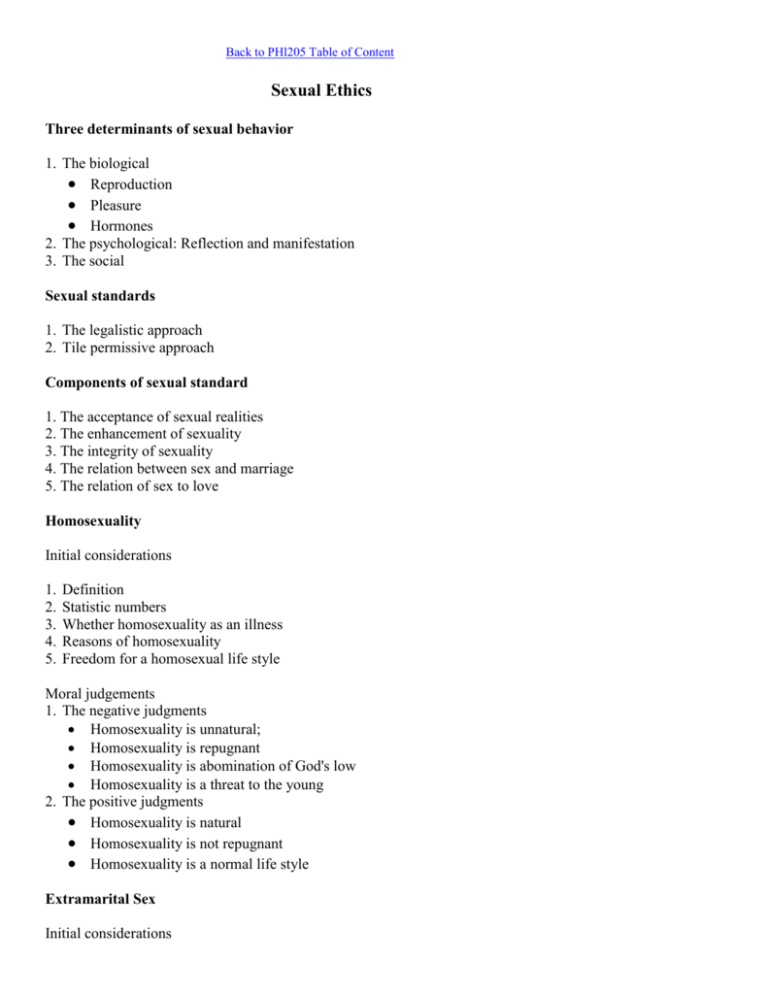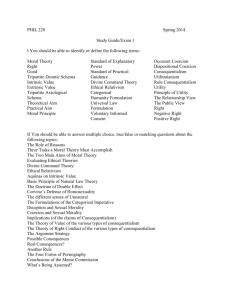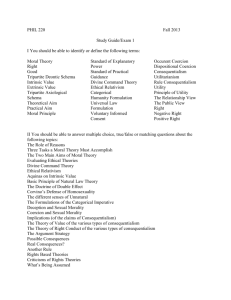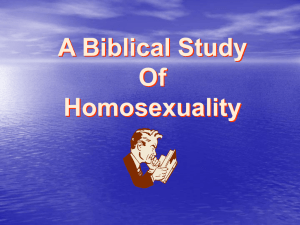
Back to PHl205 Table of Content
Sexual Ethics
Three determinants of sexual behavior
1. The biological
Reproduction
Pleasure
Hormones
2. The psychological: Reflection and manifestation
3. The social
Sexual standards
1. The legalistic approach
2. Tile permissive approach
Components of sexual standard
1. The acceptance of sexual realities
2. The enhancement of sexuality
3. The integrity of sexuality
4. The relation between sex and marriage
5. The relation of sex to love
Homosexuality
Initial considerations
1.
2.
3.
4.
5.
Definition
Statistic numbers
Whether homosexuality as an illness
Reasons of homosexuality
Freedom for a homosexual life style
Moral judgements
1. The negative judgments
Homosexuality is unnatural;
Homosexuality is repugnant
Homosexuality is abomination of God's low
Homosexuality is a threat to the young
2. The positive judgments
Homosexuality is natural
Homosexuality is not repugnant
Homosexuality is a normal life style
Extramarital Sex
Initial considerations
1. Definition
2. The reasons
Length of separation;
Debilitating illness
Lack of interest
Sexual malfunction
Moral judgments
1. The negative judgments
Violates the contract
Injures the partner psychologically
Remains a mockery to the traditional concept of marriage
2. The positive judgments
Private life style
Sexual freedom
Sexual pleasure in human nature
Abortion
A Historical review
1.
2.
3.
4.
The positive attitudes of hellenism
The negative attitudes of medieval church
The modern arguments
Legitimization of abortion
Roe v Wade: Supreme Court's decision
1. The major grounds for the Court's decision
Social changes
The concept of privacy
Human rights
Determination of the meaning of the term "person" in relation to the abortion controversy
2. Four decisions according to three "trimesters" of pregnant
3. Seven attempts to circumvent the Court's action
Biological background
The development of the human fetus
1. Developmental timetable
Spermatozoon--Zygote--Blastocyst--Embryo--Fetus--Quickening--viabi1ity
2. Miscarriages
3. Forms of abortion
Spontaneous abortion (anytime)
Drug such as "morning-after pill"
Uterine or vacuum aspiration (through week 12)
Dilation and curettage (through week 12)
Saline injection (after week 16)
Hysterotomy (after week 16)
Two status of the fetus
1. The ontological status
It bears directly on the issue of fetal rights and permissible treatment of the fetus
Four questions:
(1) whether the' fetus is an individual organism
(2) whether the fetus is biologically a human being
(3) whether the fetus is psychologically a human being;
(4) whether the fetus is person
The meaning of the expression human life:
(1) the biological
(2) the psychological
The concept of' "personhood"
Three positions on when extreme conservative;
(1) The extreme conservative
(2) The extreme liberal
(3) The moderate
2. The moral status
The basic moral problem of abortion is: Under what condition is abortion morally justifiable?
The negative judgments
As murder
Sets a dangerous precedent
Involves psychological risks for woman
Ignores the responsibility for woman's sexual activity
The positive judgments
Dangerous pregnancies;
Unwanted or deformed unborn
Some Pregnancies resulted from rape or incest
Woman's rights over their bodies
Premarital Sex
Initial considerations
1. Definition
2. The reasons
Moral judgements
The negative judgments
Violates God's law
Undermines marriage
Results bastards
Encourages promiscuity
The positive judgments
Private matter
Celibacy as unnatural and unfair
Sexual compatibility
Pornography
Conceptualization
1.
2.
3.
4.
The literal: Obscenity
The legal: Four basic characteristics by Supreme Court
The religious
The psychological
Moral judgements
1. The negative judgements
Degrades humans
Separates sexual passion from affection and love
2. The positive judgements
A useful source of information about human sexuality
Morally natural
Two conflict arguments on censorship
1. The negative arguments
2. The positive arguments







